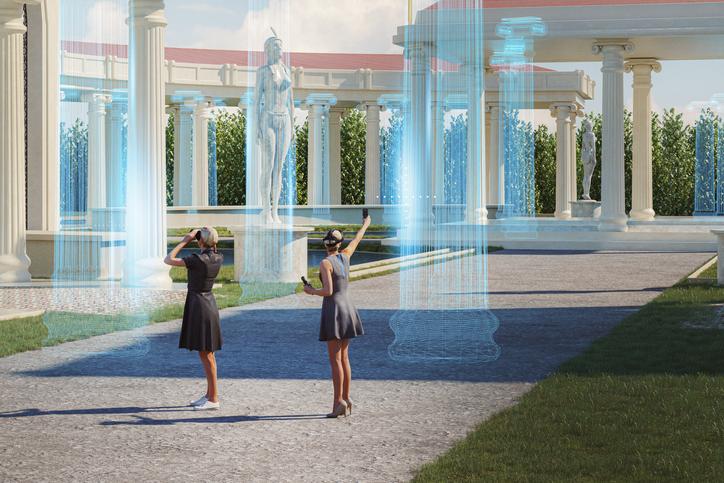The Rise of Virtual Campus Tours: Making the Most of the Digital Experience
Virtual campus tours have long been a part of higher education marketing plans as a way for colleges and universities to highlight their focus on the use of technology. In recent years, these tours have become practically a necessity as students searched for safe ways to plan for their education during the pandemic. Now, the use of interactive virtual tours continues to rise, and knowing how to make the most out of the digital experience gives higher education facilities a leading edge in showcasing what makes their programs valuable to prospective students.
The Changing Landscape of Campus Tours
For decades, in-person tours were the standard method for higher education institutes to use to demonstrate their highlights to students who choose to attend a specific program of study. While there are still benefits offered by walking a student through each part of the campus in person, there are also some limitations that come with only offering in-person tours as an option.
Many students simply lack the time or financial resources to attend in-person tours. International students are especially limited when they cannot attend in-person tours, which is a major setback for universities that focus on global education experiences. Even local students may decide to narrow their search to only a few select programs when they are unable to tour multiple campuses across a wide swath of states.
Now that campus tour technology makes it possible to replicate in-person tours that prospective students and their families can take from their homes, choosing to offer virtual tour options opens up more higher education marketing opportunities. Students also benefit from being able to expand their search for the perfect educational program to fit their needs.
Advantages Offered By Virtual Campus Tours
Greater accessibility for a global audience isn’t the only advantage of virtual tours. The benefits of virtual tours also include higher visibility among local students, with a 258% rise in participating high school seniors in recent years. Given the higher visibility rates, virtual tours are also one of the more cost-effective options for higher education marketing plans. While the tours need to be updated periodically, they can often be used for several years to maximize the return on the investment.
Technology Driving Virtual Campus Tours
Campus tour technology goes far beyond offering a few basic photos for online tours. Today, higher education institutions can provide prospective students with 360-degree tours using photography and videography technology. Virtual reality in education also brings these tours to life, with students being able to connect the tour to their headsets to gain what feels like a true in-person view of the facility. Being able to use an augmented reality application to walk through interactive maps and multimedia content helps students to get a feel of what life is really like on the campus.
Navigating Interactive Virtual Tours
Although the use of virtual tours is rising, many students and parents are still new to using this technology. As a student or parent, it’s important to know how to get the most out of your experience. Higher education institutions that focus on promoting authenticity in virtual tours tend to include several multimedia experiences that include everything from 360-degree views of the campus to interactive chats.
If a program offers virtual reality tours, then make sure to use a headset if it’s possible to provide you with the full experience. You’ll also want to carve out time to walk through each of the interactive elements and discuss them with your family. Taking detailed notes can also help you remember which programs appealed to your interests and goals. Since virtual tours tend to bring a campus to life, it’s important to maintain a perspective that helps you remember what a specific program offers for your academic career along with opportunities for socialization.
Customizing the User Experience
Providing personalized campus visits helps your institution to make strong connections with people from a variety of different audiences. Naturally, you’ll want to include the general virtual tour that you give new undergraduates in your plans. But, your higher educational facility may also need to provide special tours for graduate students, international students and parents and family members that highlight how the program fits their specific interests.
Interactive Features and Engagement Options
Virtual open houses and webinars are common ways to encourage engagement with prospective students and the people who are involved at your higher education facility. Virtual tours are also more effective when they provide interactive features that encourage people to personally connect with other students and faculty members. Hosting Q&A sessions with current students or web chats with admissions staff members are effective options to consider adding to the virtual tour schedule.
Fordhum University is one higher education institution that offers students the option of either attending a general virtual tour, or they can opt for a personalized one that they take virtually using live streaming. Offering more virtual options has led to them seeing their rates of students taking online tours rising from 730 to 2,200 within the space of a year.
Overcoming Common Challenges
As with any marketing tool, there are some challenges that higher education institutions need to be aware of. Fortunately, they are also manageable by using the best practices for including virtual technology in campus tours. For example, making sure that the tours are authentic and highlight the real life experience of students is easier when you include insights from people who actually spend time on campus.
Although the absence of a physical interaction is noticeable during virtual tours, it is possible to overcome this challenge by using technology to its fullest capacity. Virtual reality tours make it feel more like the person is present on campus. Live chats and streams also give viewers an in-the-moment experience that feels more like they are attending an event in person.
Success Stories
Over the past few years, more higher education institutions have included virtual tours in their programming to attract people when traveling was limited during the pandemic. The University of Berkeley is well-known for their use of 360-degree campus tours that have brought 22,000 unique visitors to their site along with 3,000 more who chose to tour specific aspects of the campus, such as residential halls.
Auburn University is another campus that attracts more students virtually from all over the world than who attend their in-person tours. Once a higher institution opens up their campus to a wider audience, the results tend to occur quickly with most bolstering their visitors by thousands over the course of an enrollment period.
The Future of Campus Tours
The future is wide open for bringing more interaction to virtual tours. Currently, the focus is on adding more augmented reality experiences to tours that heighten the emotional response among viewers that translates to higher enrollment rates. As technology continues to advance, greater personalization is also on the horizon that gives every student or family member the answers they need to their unique questions.
Making the Most Of the Digital Experience
Awareness of the tools that are available for promoting online engagement in higher education is the first step towards capitalizing on the digital experience. On top of opening up tours to a global audience, utilizing virtual technology also helps to bring the campus experience to life in ways that generate an emotional response among prospective students.
Giving virtual tours a try benefits everyone who is in the process of exploring higher education opportunities, and programs that focus on staying up-to-date regarding their use of technology maintain a leading edge when it comes to student recruitment. From creating a virtual walk through of the main campus to giving prospective students a chance to speak with someone from their future educational program, there are multiple ways to use technology to bring everyone closer.

